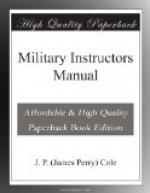FIRST CYCLE.—1 arm. A to G. One arm always at the interval. Be sure to make the “D” with right arm straight overhead—then it is more distinct at a distance. (Plate.)
SECOND CYCLE.—2 arms. H to N, inclusive, with exception of J. One arm always in the A position. In making I always be sure that the left hand is at the A position. Some men insist in making this letter wrong by crossing the body with the left hand uppermost. This is very awkward and also very indistinct at a distance. P changes arms but retains same relative position of flags.
THIRD CYCLE.—2 arms. T and U. Right arm in position of C. Letter U actually resembles that letter.
THIRD CYCLE.—2 arms. O to S. One arm always in B position. In letter O, left arm is in B position; in all others, right arm.
FOURTH CYCLE.—2 arms. T and U. Right arm in position of C. Letter U actually resembles that letter.
DOUBLES.—L, U, R, N. These letters are keys to many others and should be promptly learned.
OPPOSITES.—V and K, O and W, Q and Y, S and M, Z and H, X and I, M follows L in cycle and is opposite of S, S follows E in cycle and is opposite of M, K precedes L in cycle and is opposite of V. Figures are first 10 letters of alphabet, preceded by crossing flags overhead.
INSTRUCTING.—This plan of teaching the semaphore will be found very helpful, for it helps to reason out the alphabet for the student. By fixing firmly in mind a few things the student can soon reason out the alphabet for himself by a very logical plan.
SECOND STEP.—After the men have been taught the alphabet they should either pair off and one man send to the other, or one man should be selected to send for the entire class. At first only letters should be sent until the men have learned the alphabet thoroughly. In this way the key characters of the alphabet can be fixed in mind, as well as their relation to the other letters.
THIRD STEP.—The men should next be paired off and instructed to send simple messages to each other. You should insist that there be no other communication between the men than by means of their flags.
FOURTH STEP.—Proceed to simple qualification tests, four men working in two pairs and the pairs alternating in sending and receiving. One man of first pair should read for his companion to send. On the other end, one man should read and the other copy. The distances should be such as to preclude the possibility of conversation. Forty letters per minute is a fair test; or this system may be followed: Have a good signalman send 10 combinations of 5 letters each to the whole class. The men should read these and write them down, one combination at a time. Time limit should be 3 minutes.
[Illustration: Plate 13]




